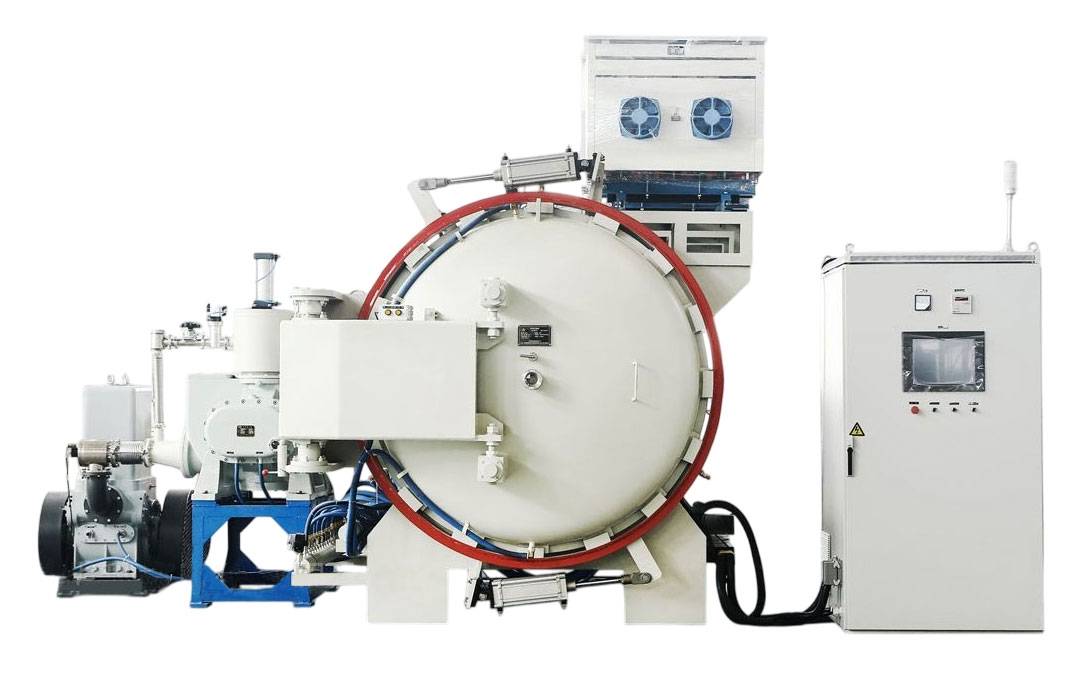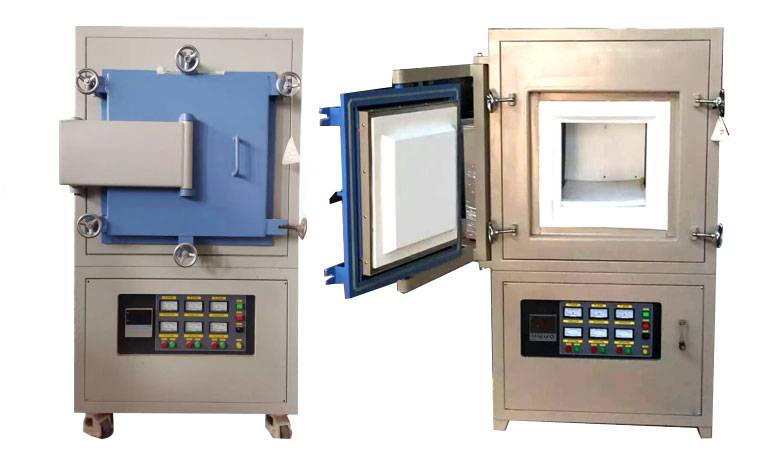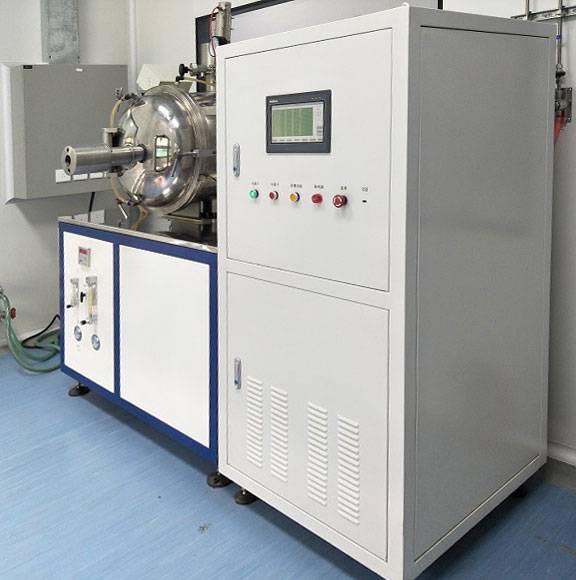Types of Advanced Ceramic Sintering Furnaces
Vacuum Sintering Furnace
Vacuum sintering furnaces operate by placing ceramic materials into a specialized furnace chamber, which is subsequently evacuated to create a vacuum environment. This vacuum state is crucial as it eliminates atmospheric gases that could otherwise interfere with the sintering process. The furnace is then heated, allowing the ceramic material to reach exceedingly high temperatures where chemical reactions and crystallization can occur.
During the sintering process, critical parameters such as temperature, vacuum level, and pressure are meticulously controlled. These parameters play a pivotal role in determining the quality and performance characteristics of the final ceramic products. For instance, precise temperature control ensures that the material reaches the optimal sintering temperature without causing thermal degradation. Similarly, maintaining the correct vacuum level helps in preventing unwanted reactions with residual gases, thereby preserving the purity and integrity of the ceramic material.
Moreover, the flexibility of vacuum sintering is particularly advantageous for producing intricate and delicate components that are challenging to manufacture through conventional methods like casting or machining. This method not only minimizes waste but also yields parts with exceptional consistency and brightness, devoid of seams, joints, or fillers. Industries using powdered metal, metal injection molding, and 3D printing technologies can significantly benefit from the superior quality and design flexibility offered by vacuum sintering.

In summary, vacuum sintering furnaces offer a robust solution for producing high-quality ceramic products with precise control over critical sintering parameters, making them indispensable in advanced ceramics manufacturing.
Atmosphere Sintering Furnace
The operation of an atmosphere sintering furnace revolves around the precise control of the internal atmosphere to facilitate the sintering and hardening of ceramic materials. This type of furnace is equipped with several critical components, including a heating unit, a pressure mechanism, a sintering chamber, and a gas control system. These elements work in tandem to create an environment conducive to the desired chemical and physical transformations in the ceramic materials.
The heating unit is responsible for elevating the temperature within the sintering chamber, while the pressure mechanism ensures that the correct atmospheric pressure is maintained. The sintering chamber, which houses the ceramic materials, is designed to withstand high temperatures and pressures, providing a stable environment for the sintering process. The gas control system is integral to the operation, allowing for the introduction and regulation of various gases, such as oxidizing, neutral, or reducing atmospheres, depending on the specific requirements of the ceramic material being processed.
In addition to these core components, the atmosphere sintering furnace often features advanced sealing technologies, such as high-temperature-resistant silica gel seal rings on the furnace door, to ensure optimal sealing and prevent any leakage of the controlled atmosphere. This precision in atmosphere control is crucial for achieving the desired properties in the final ceramic product, making the atmosphere sintering furnace a versatile and essential tool in the advanced ceramics industry.

Hot Press Sintering Furnace
The working principle of the hot press sintering furnace involves leveraging high temperature and high pressure within a vacuum environment to transform ceramic powder into a solid material. In this process, the ceramic powder is heated to a critical temperature, at which point it undergoes a fusion under substantial pressure, resulting in a dense, solid form.
Key Features of Hot Press Sintering
- High Density and Performance: The hot pressed products exhibit extremely low porosity, with densities nearly reaching the theoretical maximum. This high density contributes to superior hardness and wear resistance, making these products ideal for precision tools and high-precision wear parts.
- Efficient Pressure Application: The required unit pressing pressure for hot pressing is significantly lower than that for cold pressing, allowing for the production of larger products. This efficiency extends to the ability to produce complexly shaped products, such as thin-walled tubes and ball and pillar products.
- Minimal Deformation: One of the significant advantages of hot pressing is its ability to produce large, non-deformed products. This method overcomes the deformation issues common in cold pressing, enabling the creation of long, straight parts and hollow products with accurate dimensions.
- Single-Piece Production Suitability: Hot pressing tools are relatively easy to manufacture and have a short production cycle, making this method particularly suitable for single-piece or small batch production needs.
- Operational Complexity: Despite its advantages, hot pressing requires a high level of operational skill. Factors such as temperature and pressure control, as well as the speed of heating and cooling, are critical to achieving optimal product performance and minimizing defects.
Limitations
- Low Productivity and High Costs: The hot pressing method typically produces only one to a few products at a time, with molds being costly and having a short service life. This makes it less suitable for mass production scenarios, where cold sintering methods are generally preferred.
In summary, the hot press sintering furnace offers a unique combination of high-quality output and flexibility, though it comes with the trade-offs of higher operational complexity and cost.
Microwave Sintering Furnace
The working principle of a microwave sintering furnace revolves around the utilization of microwave radiation to induce heat within ceramic materials. This process leverages the unique waveband of microwaves, which interacts with the fine structure of ceramics to generate internal heat. As a result, the ceramic material undergoes uniform heating throughout the electromagnetic field, reaching the sintering temperature necessary for densification.
Unlike conventional furnaces, microwave sintering furnaces offer several distinct advantages. They provide rapid and uniform heating, which is particularly beneficial for achieving precise temperature control and enhancing energy efficiency. These furnaces are available in various configurations, including tabletop models for laboratory experiments and continuous models designed for production plants. Some models even combine microwave energy with electrical heaters to accommodate materials that do not absorb microwaves effectively at lower temperatures.

The operational capabilities of microwave sintering furnaces are extensive. They can handle a wide range of process temperatures, from 1750°C in high-temperature models to more moderate levels in tabletop versions. These furnaces are equipped with advanced features such as non-contact temperature monitoring, digital displays for power and temperature, and sophisticated process control using high-end PID controllers. Additionally, they support sintering in different atmospheres, including inert, reducing, and oxidizing environments, making them versatile for various ceramic applications.
In summary, microwave sintering furnaces represent a cutting-edge technology in the field of advanced ceramics manufacturing. Their ability to achieve rapid, uniform heating and their adaptability to different processing conditions make them a valuable tool for both laboratory research and industrial production.
Advantages and Disadvantages of Each Sintering Furnace Type

Vacuum Sintering Furnace
Advantages:
-
Oxidation and Contamination Prevention: Vacuum sintering furnaces excel in creating an environment where oxidation and contamination are virtually eliminated. This makes them ideal for processing high-purity and high-temperature ceramic materials, ensuring that the final product retains its integrity and purity.
-
Design Flexibility: The process allows for incredible design flexibility, enabling the production of intricate and delicate components that would be difficult or impossible to achieve through traditional casting or machining methods. This flexibility is particularly beneficial for small or complex parts.
-
Superior Quality and Consistency: Vacuum sintering produces parts with no seams, joints, or fillers, resulting in a consistent, bright finish. This method is particularly advantageous for technologies like powdered metal, metal injection molding, and 3D printing, which can benefit from the superior quality and flexibility offered by vacuum sintering.
Disadvantages:
-
High Equipment Costs: The initial investment in vacuum sintering equipment is substantial, making it a less accessible option for smaller operations or startups. The high cost is a significant barrier to entry for many potential users.
-
Specialized Skills Required: Operating a vacuum sintering furnace requires specialized knowledge and skills. Technicians must be trained to handle the complex machinery and understand the intricacies of the sintering process, which can be a limiting factor for some organizations.
-
Complex Process: The process of vacuum sintering is not straightforward and involves several stages, including debinding, which can complicate the production timeline. This complexity can lead to longer turnaround times and increased operational challenges.
In summary, while vacuum sintering furnaces offer numerous advantages in terms of product quality and design flexibility, they come with significant drawbacks in terms of cost and operational complexity. These factors must be carefully considered when deciding whether vacuum sintering is the right choice for a particular manufacturing process.
Atmosphere Sintering Furnace
The atmosphere sintering furnace offers a unique capability to manipulate the composition and microstructure of ceramic materials, making it particularly suitable for handling atmosphere-sensitive materials. This type of furnace is equipped with a sophisticated gas control system that allows for the introduction and regulation of various atmospheres, including oxidizing, neutral, reducing, alkaline, and acidic environments. This flexibility enables precise control over the sintering process, ensuring that the final product meets specific performance criteria.
However, the operational complexity of the atmosphere sintering furnace is a significant drawback. The requirement for specific gases and the intricate setup necessary to maintain the desired atmosphere add layers of complexity to its operation. For instance, the furnace must be sealed with high-temperature-resistant materials, such as silica gel, to prevent gas leakage and ensure the integrity of the controlled atmosphere. Additionally, the need for specialized knowledge and skills to operate and maintain the furnace can be a barrier for some users.
Despite these challenges, the atmosphere sintering furnace remains indispensable in industries where the quality and properties of ceramic materials are paramount. Its ability to create a tailored sintering environment makes it a preferred choice for applications ranging from the sintering of diamond saw blades to the heat treatment of copper materials and steel strips. This versatility underscores the importance of the atmosphere sintering furnace in advanced ceramic manufacturing, balancing its technical complexity with the high-quality results it delivers.
Hot Press Sintering Furnace
Advantages: The hot press sintering furnace is particularly advantageous for creating complex and porous structures, which are often difficult to achieve with other sintering methods. This process significantly enhances the product's strength by achieving high density and near-theoretical density levels. The low porosity and fine grain structure resulting from hot pressing contribute to superior hardness and wear resistance, making it ideal for manufacturing precision tools and high-precision wear parts.
Disadvantages: Despite its numerous benefits, the hot press sintering furnace comes with significant drawbacks. The equipment is costly to acquire and maintain, which can be a prohibitive factor for many manufacturers. Additionally, the process requires uniform pressure application, which necessitates precise control mechanisms and skilled operators. The high operational technical requirements and the limitations in production volume further contribute to its high cost, making it less suitable for mass production scenarios.
Microwave Sintering Furnace
The microwave sintering furnace operates by leveraging microwave radiation as the primary heating source, offering several advantages over traditional furnaces. One of the most significant benefits is its ability to achieve rapid and uniform heating, which can significantly reduce sintering times. This efficiency is particularly beneficial in industrial settings where production speed is critical. Moreover, microwave sintering is inherently energy-efficient, as it directly heats the material rather than the surrounding environment, minimizing energy loss.
However, the adoption of microwave sintering technology is not without its challenges. The initial investment in equipment can be substantial, and the technology requires a deep understanding of complex microwave systems. These systems often include features such as non-contact temperature monitoring, digital displays of power and temperature, and high-end PID controllers for precise process control. Additionally, the ability to sinter materials in various atmospheres, including inert, reducing, and oxidizing environments, adds to the versatility but also the complexity of these furnaces.
For laboratory applications, tabletop microwave sintering furnaces are available, packed with advanced features to facilitate preliminary sintering experiments. On the production scale, continuous microwave sintering furnaces offer throughput ranging from 50 to 1000 kg/day, with customizable cross-sections to suit various material processing needs. Despite the high costs and technical expertise required, the benefits of microwave sintering furnaces make them a compelling option for advanced ceramic manufacturing.
Related Products
- Vacuum Heat Treat and Pressure Sintering Furnace for High Temperature Applications
- Vacuum Heat Treat and Sintering Furnace with 9MPa Air Pressure
- Spark Plasma Sintering Furnace SPS Furnace
- Small Vacuum Heat Treat and Tungsten Wire Sintering Furnace
- Mesh belt controlled atmosphere furnace
Related Articles
- How Vacuum Induction Melting (VIM) Transforms High-Performance Alloy Production
- How Vacuum Induction Melting Ensures Unmatched Reliability in Critical Industries
- Exploring Spark Plasma Sintering Furnace (SPS): Technology, Applications, and Advantages
- Vacuum Hot Press Furnace: A Comprehensive Guide
- Mastering Vacuum Furnace Brazing: Techniques, Applications, and Advantages



















